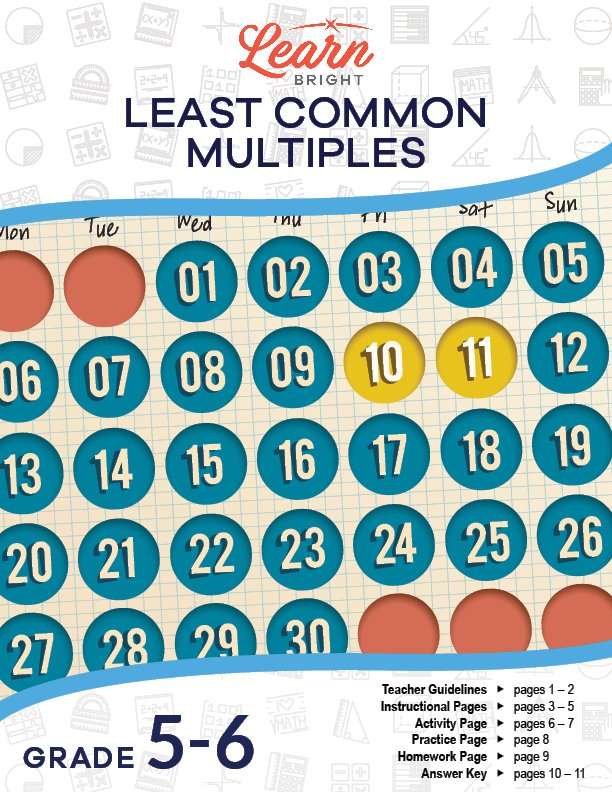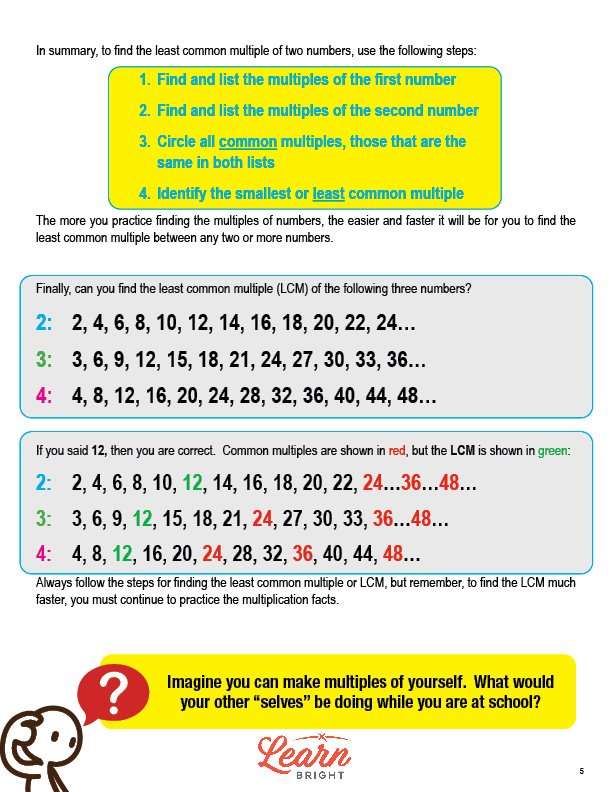Description
What our Least Common Multiples lesson plan includes
Lesson Objectives and Overview: Least Common Multiples teaches students how to find the least common multiples of two numbers. At the end of the lesson, students will be able to find the least common multiple of two whole numbers less than or equal to 12. This lesson is for students in 5th grade and 6th grade.
Classroom Procedure
Every lesson plan provides you with a classroom procedure page that outlines a step-by-step guide to follow. You do not have to follow the guide exactly. The guide helps you organize the lesson and details when to hand out worksheets. It also lists information in the blue box that you might find useful. You will find the lesson objectives, state standards, and number of class sessions the lesson should take to complete in this area. In addition, it describes the supplies you will need as well as what and how you need to prepare beforehand.
Options for Lesson
Included with this lesson is an “Options for Lesson” section that lists a number of suggestions for activities to add to the lesson or substitutions for the ones already in the lesson. One optional adjustment to the lesson activity is to start with one die for each pair of students then give a second die after several rounds. Another adjustment to the activity is to have one student roll one die and another roll two dice. If you want to expand this lesson, you can show students how to find equivalent fractions. Finally, for an additional activity, you could have your students create word problems related to finding multiples and share with other students to solve.
Teacher Notes
The teacher notes page includes a paragraph with additional guidelines and things to think about as you begin to plan your lesson. This page also includes lines that you can use to add your own notes as you’re preparing for this lesson.
LEAST COMMON MULTIPLES LESSON PLAN CONTENT PAGES
What is a Multiple?
The Least Common Multiples lesson plan includes three content pages. The word multiply sounds a lot like the word multiple. Multiples are numbers that you get when you multiply a number by another number (other than zero!). All of the numbers on a multiplication table are considered multiples.
For example, to find the multiples of the number 3, we multiply 3 by other numbers: 3 x 1 = 3, 3 x 2 = 6, 3 x 3 = 9, 3 x 4 = 12, 3 x 5 = 15, 3 x 6 = 18, 3 x 7 = 21. The products of these equations (3, 6, 9, 12, 15 , 18, and 21) are multiples of 3. However, these are not the only multiples of 3. Other multiples of 3 include 24, 27, 30, 33, 36, 39, and on for infinity.
Let’s look at some other examples. Some multiples of 5 include 5, 10, 15, 20, 25, 30, 35, 40, 45, 50, 55, and 60. Some multiples of 9 include : 9, 18, 27, 36, 45, 54, 63, 72, 81, 90, 99, and 108. We can see patterns in these lists of multiples.
It’s important to know how to find the multiples of a number. This will help you learn multiplication facts and find equivalent fractions. Also, once you can find the multiples of a number, you can easily find the least common multiple of two numbers. This is helpful for finding common denominators for fractions. It also helps you add and subtract fractions.
Finding Least Common Multiples
As you may have noticed, some numbers have some of the same (also known as common) multiples. In the above examples, 5 and 9 have the common multiple 45.
Let’s find the common multiples of 4 and 6. First, we need to find the multiples of each number. The multiples of 4 include 4, 8, 12, 16, 20, 24, 28, 32, 36, 40, 44, and 48. The multiples of 6 include 6, 12, 18, 24, 30, 36, 42, 48, 54, and 60. Next, let’s look at these lists of multiples and find the common multiples. They are 12, 24, 36, 48, and 60. If we found more multiples of each number, we would find more common multiples as well!
Any two numbers have at least one common multiple, but some will have many more. The easiest way to find a common multiple of two numbers is to multiply them together. For example, 20 is a common multiple of 4 and 5 because 4 x 5 = 20.
48 is a common multiple of 6 and 8 because 6 x 8 = 48. However, 48 is not the least common multiple of 6 and 8. The least common multiple, or LCM, is the smallest common multiple of two numbers. Let’s find the LCM of 6 and 8. First, we look at the list of multiples for each number. The multiples of 6 include 6, 12, 18, 24, 30, 36, 42, 48, 54, 60, 66, and 72. The multiples of 8 include 8, 16, 24, 32, 40, 48, 56, 64, and 72. Even though 48 is one of their common multiples, the LCM of 6 and 8 is 24.
Let’s summarize! To find the least common multiple of two numbers, you follow four easy steps. First, find and list the multiples of the first number. Second, find and list the multiples of the second number Third, identify all of the common multiples. Fourth, identify the smallest or least common multiple! The more you practice finding the LCM, the easier it will be.
We can also find the LCM of more than two numbers. For example, let’s say we wanted to find the LCM of 2, 3, and 4. First, we list the multiples of each number. After we do that, we compare the lists and find the smallest number in all three lists. For 2, 3, and 4, the LCM is 12!
LEAST COMMON MULTIPLES LESSON PLAN WORKSHEETS
The Least Common Multiples lesson plan includes three worksheets: an activity worksheet, a practice worksheet, and a homework assignment. You can refer to the guide on the classroom procedure page to determine when to hand out each worksheet.
DICE ACTIVITY WORKSHEET
Students will work with a partner to complete the activity worksheet. Each student will roll two dice, writing the numbers on the worksheet. They will then find the multiples of each number, circling the common multiples, and writing the least common multiple in the box on the worksheet.
LIST THE MULTIPLES PRACTICE WORKSHEET
For the practice worksheet, students will first list the multiples for each number listed. Next, they will list the multiples for each pair of numbers listed, circling any common multiples. Finally, they will list the multiples for each pair of numbers listed, circling the least common multiple for each pair.
LEAST COMMON MULTIPLES HOMEWORK ASSIGNMENT
Like the practice worksheet, for the homework assignment, students will first list the multiples for each number listed. Next, they will list the multiples for each pair of numbers listed, circling any common multiples. Finally, they will list the multiples for each pair of numbers listed, circling the least common multiple for each pair.
Worksheet Answer Keys
This lesson plan includes answer keys for the practice worksheet and the homework assignment. If you choose to administer the lesson pages to your students via PDF, you will need to save a new file that omits these pages. Otherwise, you can simply print out the applicable pages and keep these as reference for yourself when grading assignments.









